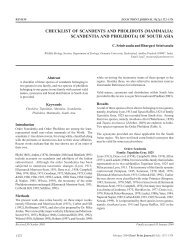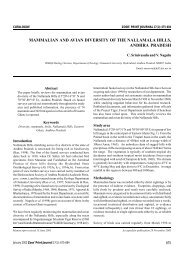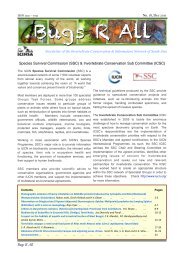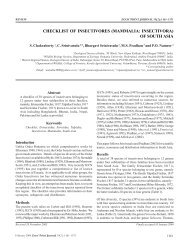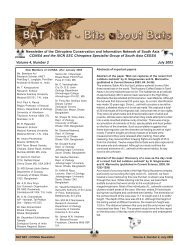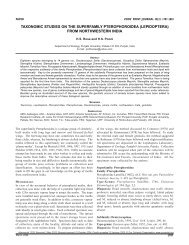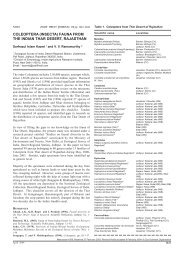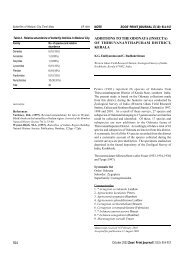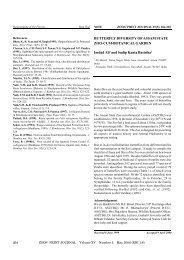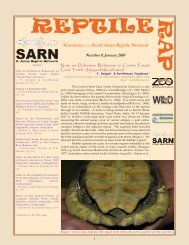Kiran Diversity and seasonal fluctuation of zooplankton ... - zoo's print
Kiran Diversity and seasonal fluctuation of zooplankton ... - zoo's print
Kiran Diversity and seasonal fluctuation of zooplankton ... - zoo's print
Create successful ePaper yourself
Turn your PDF publications into a flip-book with our unique Google optimized e-Paper software.
Insect fauna <strong>of</strong> Neyyar Wildlife SanctuaryG. Mathew et al.Scientific names Remarks Scientific names RemarksNacoleia diemenalis Guen.Common on pulsesNephoteryx atrisquamella Hamp. -Nephoteryx fluctuosalis Zell.Common on GraminaeNephoteryx foedalis Guen.Common on GraminaeProtrigonia zizanialis Swinh. -Psara bipunctalis Fb.Common on pulsesPycnarmon caberalis Guen.Common on coleusPygospila tyres Cram. -Sylepta sp. -Syngamia abruptalis WalkerCommon on OcimumSyngamia latimarginalis Walker -Syngamia sp. -Terastia egialealis WalkerCommon on ErythrinaSphingidaeAcherontia lachesis Fb.CommonAcherontia sp.CommonHerse convolvuli Lin.CommonTheretra sp. -SaturnidaeLoepa sikkima Moore -ColeopteraOdontolabis cuvera Hope -Odontolabis sp.CoccinellidaeCoccinella septempunctata Lin. -Epilachna septima Dieke -E. vigintioctopunctata Fb. -ScarabaeidaeAnomala ruficapilla BurmeisterAdults feed on foliageAnomala sp.Adults feed on foliageCopris sp.Dung rollingHeliocopris dominus BatesDung rollingHeterorrhina sp. -Holotrichia ruf<strong>of</strong>lava BrenskeGrubs feed on rootsHolotrichia fessa BrenskeGrubs feed on rootsHolotrichia serrata Fb.Grubs feed on rootsMaladera sp.Adults feed on foliageMimela sp.Adults feed on foliagePopillia complanata Newm.Adults feed on foliageBuprestidaeChrysochroa sp.Common in woody stemCerambycidaeAcanthophorus serraticornis Oliv. PolyphagousBatocera sp.PolyphagousCerosterna scabrator (Fb.)PolyphagousNupserha madurensis Pic. -Nupserha malabarensis Pic. -Prionomma atratum Gmelin. -Plocaederus obesus -ChrysomelidaeAulacophora cincta (Fb.)Feeds on foliageAulacophora unicolor Illig.Feeds on foliageBasilepta fulvicornis Jac.Feeds on foliageHoplasoma unicolor Illig.Feeds on foliageMonolepta longitarsis Jac.Feeds on foliageCurculionidaeMyllocerus viridanus Fb.Polyphagous, feeds on foliageDynastidaeOryctes rhinoceros Lin.Common on palmsLampyridaeEpicauta sp. -HemipteraEurybrachidaeEurybrachis sp. -RicaniidaeRicania sp. -FlattidaeFlata ? ocellata Fb. -DictyopharidaeDictyopharina ?viridissima Melicher -CercopidaeCosmocarta relata Dist. -LygaeidaeDindymus lanius Stal. -Macropes sp. -FulgoridaeKalidasa lanata Drury -CicadellidaeBothrogonia ferruginea Fb. -Krishna strigicollis Spinola -Tettigoniella indistincta Walker -PentatomidaeNezara viridis Lin.Common on ear-head <strong>of</strong> paddyPlacosternum taurus (Fb.) -Dysdercus cingulatus Fb.Cotton bugSerinatha augur Fb. -HymenopteraApidaeApis dorsata Fb.Honey beeApis indica Fb.Honey beeXylocopidaeXylocopa verticalis Lepel.Carpenter beeEumenidaeEumenes conica Fb.Mud waspScoliidaeMegascolia sp. -PompilidaeSalius aureosericeus Guer. -SphecidaeAmmophila laevigata Smith. -Chalybion bengalense Dahl. -Sceliphron javanum Lepel. -ChrysididaeStilbum cyanurum ForsterCockoo waspVespidaeVespa sp.nr.cincta Fb. -OdonataOrthetrum pruinesum neglectum (Ramb.) -Macromia sp. -Nemothemis fulvia Drury -Nemothemis intermedia (Ramb.) -Trithemis aurora (Burm.) -Trithemis festiva (Ramb.) -DipteraMuscidae - 10 spp.Philebotomodae - 2 spp.Tabanidae - 2 spp.Syrphidae - 2spp.Culicidae - 5spp.OrthopteraAcrididaeConocephalus sp.. -Mecopoda sp. -Acrida lugubris Bur. -Acrida sp. -Phlaeoba sp. -Bacunculidae sp. -DictyopteraMantidaeDeroplatys desicata WestPreying mantisHumbertiella indica Sauss.Preying mantis- habits not known2932December 2007 Zoos' Print Journal 22(12): 2930-2933
Insect fauna <strong>of</strong> Neyyar Wildlife SanctuaryG. Mathew et al.NOTE ZOOS' PRINT JOURNAL 22(12): 2933-2934ASSOCIATION OF MOLOIDOGYNE INCOGNITAAND OTHER PLANT PARASITICNEMATODES WITH DIFFERENT CROPS OFMANIPURL. Joymati <strong>and</strong> W. MemaDepartment <strong>of</strong> Zoology, G.P. Women’s College, Imphal, Manipur795001, IndiaFigure 1. Map <strong>of</strong> Neyyar Wildlife Sanctuaryexcreta. These insects have great ecological significance, as thephytophagous insects are primary herbivores. The scavengerbeetles are important in the conversion <strong>of</strong> dead organic matter<strong>and</strong> have important roles in nutrient cycling.Among bugs, most species collected were phytophagous.Several species <strong>of</strong> hemipteran bugs belonging to the familiesPyrrhocoridae, Scutellaridae, Cydnidae, Fulgoridae <strong>and</strong> Cicadidaewere recorded.The hymenopterans contained two species <strong>of</strong> honeybees, onespecies each <strong>of</strong> solitary bee <strong>and</strong> bumble bee <strong>and</strong> eight species <strong>of</strong>wasps. Although 21 dipteran fly species were collected none couldbe identified. In addition to these, several species <strong>of</strong> soil insects(termites <strong>and</strong> collembolans) had been collected <strong>and</strong> described fromthis region (Prabhoo, 1971).Conclusion: Being a short-term study, only limited areas couldbe covered. Preliminary observations suggest Meenmutty inNeyyar as a biologically rich area. Both areas contain severalrare <strong>and</strong> protected species <strong>of</strong> butterflies <strong>and</strong> moths. More intensivesurvey spread over different seasons would be required to providea complete picture <strong>of</strong> the faunal diversity <strong>of</strong> this area.REFERENCESK.F.R.I. (1990). “People’s Campaign for Ninth Plan: District level planning”.Forest <strong>and</strong> Biodiversity, Kollam district, 57-59pp.Prabhoo, N.R. (1971). Distribution <strong>of</strong> soil <strong>and</strong> litter Collembola <strong>of</strong> southIndia. Oriental Insects 5(2): 243-262.Sreekumar, P.G. & M. Balakrishnan (1998). A Study <strong>of</strong> animal diversity inthe proposed Adirapally hydroelectric project area in Kerala. InternationalJournal <strong>of</strong> Ecolgy <strong>and</strong> Environmental Sciences 24: 393-410.ACKNOWLEDGEMENTSWe are grateful to Dr. J.K. Sharma, Director for his interest <strong>and</strong>encouragement in this study. Dr. R. Gnanaharan, Research Coordinatorkindly went through the manuscript <strong>and</strong> <strong>of</strong>fered several valuable suggestions.The cooperation rendered by Shri. Pradeep, Wildlife Warden, Neyyar <strong>and</strong>Peppara Wildlife Division <strong>and</strong> his staff is gratefully acknowledged. Dr. T.C.Narendran, Pr<strong>of</strong>essor <strong>of</strong> Entomology, Calicut University kindly identifiedseveral species <strong>of</strong> insects collected in this study.Plant parasitic nematode is an important pathogen whichcan reduce the yield <strong>of</strong> certain economically important crops.Many workers have been investigating the effect <strong>of</strong> rootknot nematode Meloidogyne incognita <strong>and</strong> their associationwith other plant parasitic nematodes infecting many crops.Queneherve et al. (1995) investigated host status <strong>of</strong> someweeds to Meloydogyne spp., Paratylenchus spp., Helicotylenchusspp., Rotylenchulus reniformis associated with vegetablescultivated in polytunnels in Martinique for 33 weed species.Khan & Khan (1996) investigated occurrence <strong>of</strong> root knotnematode M. incognita <strong>and</strong> other plant parasitic nematodeon vegetable crops in Uttar Pradesh. To investigate theeffect <strong>and</strong> their number <strong>of</strong> association with other plantparasitic nematodes infecting many crops the study has beentaken up for providing useful information in the nematodemanagement programme.Material <strong>and</strong> Methods: Altogether 81 soil samples fromrhizospheric regions <strong>of</strong> different medicinal, wild <strong>and</strong>vegetable crops infected with M. incognita were collected.The samples were brought into the laboratory for extraction<strong>of</strong> nematode by Cobb’s (1918) seiving <strong>and</strong> decanting methodfollowed by modified Baermann’s funnel technique. Theextracted nematodes were killed, fixed <strong>and</strong> transferred intoa desiccator at room temperature for about two to three weeksfor complete dehydration. The dehydrated nematodes weremounted by using De Man’s (1884) formula for denotingthe dimension <strong>of</strong> the nematode <strong>and</strong> classification systemfollowed by Siddiqi (1986) for Tylenchs. The number <strong>of</strong>genera counted in different samples were recorded accordingto the following notation.Result <strong>and</strong> Discussion: During this investigationaltogether 17 genera <strong>and</strong> 25 nematode species were foundto be associated with juveniles <strong>of</strong> M. incognita (Table 1).Out <strong>of</strong> the plant parasitic nematode Helicotylenchus spp. werefound to be most commonly found with the root knotnematode in different crops namely Cyperus brevifolius, Bidenbiternata, Dactyloctenium aegypticum, Urena lobata, Curcumalonga, Atalantia malabarica, Sacharum <strong>of</strong>ficinarum, Fragariaindica <strong>and</strong> Punica granatum. Helicotylenchus spp. is followedby Basiria varians, Cephalenchus leptus, Imphalenchus indicus,Tylenchorhynchus elegans, Scutellonema spp. Xiphinema spp.,Longidorus psidii, Ditylenchus caudatus, Pratylenchus caudatus,Hemicriconemoides mangifera, Tylenchorhynchus punensis,Psilenchus elegans,Aglenchus parvus, Coslenchus diversus, BoleodorusManuscript 1450; © ZOO; Date <strong>of</strong> publication 21 November 2007Received 12 September 2005; Revised received 19 September 2007;Finally accepted 01 November 2007December 2007 | ISSN 0973-2535 (Print edition); 0973-2551 (Online edition) www.zoos<strong>print</strong>.org2933




